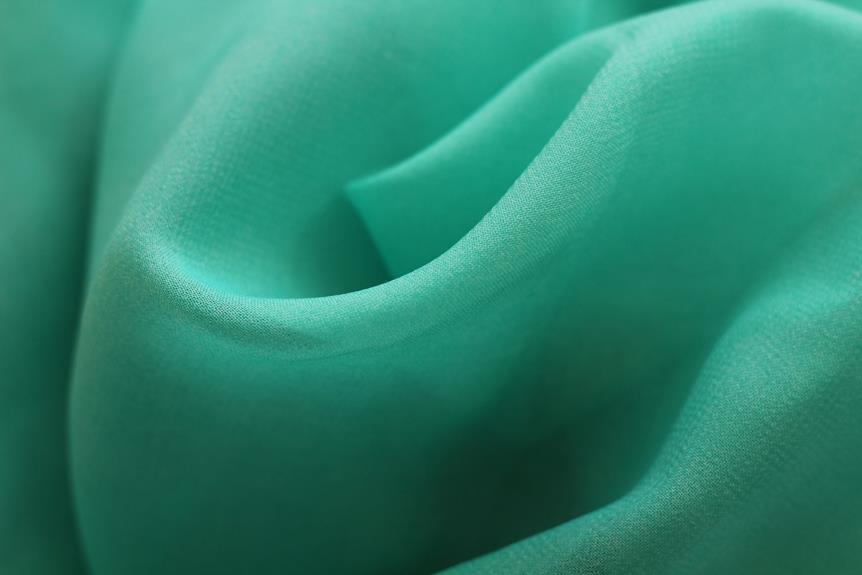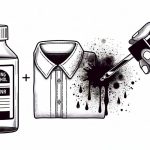So, you've got some sticky situations on your polyester fabric, huh? No worries, we've got you covered with 5 foolproof ways to remove that stubborn adhesive.
Whether it's Goo Gone or a simple vinegar and baking soda mix, we've got the tricks to tackle even the toughest spots.
From rubbing alcohol to freezing and scraping techniques, we'll show you how to make that polyester fabric good as new.
So, grab your cotton balls, paper towels, and iron, and get ready to bid adieu to those pesky adhesive marks.
Stick with us, and we'll have your polyester looking pristine in no time.
Key Takeaways
- Goo Gone and similar solvents are effective in dissolving adhesive residues on polyester fabric.
- Vinegar and baking soda can be used to create a paste that helps loosen and lift adhesive gently.
- Rubbing alcohol can be used to dab and remove adhesive without the need for chemicals.
- Freezing the fabric, scraping with a dull knife, and using a hairdryer can help remove adhesive from polyester fabric.
Goo Gone and Similar Solvents
To remove adhesive from polyester fabric, you can use Goo Gone or similar solvents. These solvents are effective in breaking down and dissolving adhesive residues without damaging the fabric. However, it's important to consider chemical safety when using these products.
Always work in a well-ventilated area, and wear gloves to protect your skin from direct contact with the solvent. Additionally, be cautious and avoid inhaling the fumes.
When applying Goo Gone or similar solvents, start by testing a small, inconspicuous area of the fabric to ensure that the solvent doesn't cause any discoloration or damage. Once you've confirmed its safety, apply the solvent directly to the adhesive residue.
Allow it to sit for a few minutes to penetrate the adhesive. Then, using a clean cloth, gently blot the area to lift the dissolved adhesive. Avoid rubbing vigorously, as this could spread the adhesive or damage the fabric fibers.
Vinegar and Baking Soda
You can use a mixture of vinegar and baking soda to effectively remove adhesive from polyester fabric. This DIY fabric care method is gentle on the fabric while being tough on the adhesive. Here's how to do it:
- Create a paste: Mix equal parts of vinegar and baking soda to form a paste. The chemical reactions between the two ingredients create a foaming action that helps loosen and lift the adhesive from the polyester fabric.
- Apply the paste: Using a soft-bristled brush or a cloth, gently apply the paste onto the adhesive-affected area. Allow it to sit for 15-20 minutes to let the chemical reactions do their work.
- Rinse and launder: After the paste has had time to work, rinse the area with warm water and then launder the garment as usual. The adhesive should be effectively removed, leaving your polyester fabric clean and adhesive-free.
Using vinegar and baking soda to remove adhesive from polyester fabric is a simple, yet effective, method that leverages the chemical reactions between the two ingredients. It's a great way to care for your fabric without harsh chemicals.
Rubbing Alcohol and Cotton Ball
When removing adhesive from polyester fabric, consider using rubbing alcohol and a cotton ball as an effective method. Rubbing alcohol is a versatile household item that is great for DIY adhesive removers. Its chemical-free properties make it a gentle yet effective option for removing sticky residue from polyester fabric. Here's a simple method to use rubbing alcohol for removing adhesive from polyester fabric:
- Step 1: Soak a cotton ball in rubbing alcohol.
- Step 2: Gently dab the adhesive area with the soaked cotton ball.
- Step 3: Allow the rubbing alcohol to sit on the adhesive for a few minutes to loosen it.
- Step 4: Wipe away the loosened adhesive with a clean cloth.
| Pros | Cons |
|---|---|
| Chemical-free alternative | May require multiple applications |
| Versatile household item | Strong odor |
| Gentle on polyester fabric | Flammable |
| Effective adhesive remover | May not work on all types of adhesives |
Using rubbing alcohol and a cotton ball provides a chemical-free alternative to remove adhesive from polyester fabric, but it's essential to use it in a well-ventilated area due to its strong odor and flammability.
Freezing and Scraping Technique
Consider using the freezing and scraping technique as a method to remove adhesive from polyester fabric. This method is effective for dealing with stubborn adhesives and is one of the chemical-free methods available for adhesive removal.
Here's how to use the freezing and scraping technique:
- Freeze the Adhesive: Place the fabric in the freezer for about 30 minutes to an hour. The cold temperature will cause the adhesive to harden and become less sticky, making it easier to remove.
- Scrape Gently: After freezing, use a dull knife or a plastic scraper to gently scrape off the adhesive from the fabric. Be careful not to damage the fabric while scraping.
- Heat Treatment: After scraping off as much adhesive as possible, use a hairdryer on a low heat setting to soften and loosen any remaining adhesive. Then, continue scraping until the fabric is adhesive-free.
This technique is particularly useful for delicate polyester fabrics that may be damaged by harsh chemicals. By utilizing the freezing and scraping technique, you can effectively remove adhesive without compromising the integrity of the fabric.
Ironing and Paper Towel
One effective method for removing adhesive from polyester fabric is to utilize an iron and a paper towel. Start by placing a clean paper towel over the adhesive area. Then, with a preheated iron set to a low heat, gently press the iron onto the paper towel-covered adhesive for 10-15 seconds. The heat from the iron helps to soften the adhesive, allowing it to transfer onto the paper towel.
Be cautious not to use high heat as it may damage the polyester fabric. After ironing, carefully lift the paper towel to check if the adhesive has transferred. If there's still adhesive remaining, repeat the process with a fresh paper towel until the adhesive is completely removed.
This ironing hack, combined with paper towel tricks, can effectively remove adhesive from polyester fabric without causing damage. Remember to test the iron on a small, inconspicuous area of the fabric first to ensure that the heat doesn't cause any damage.
Once the adhesive is removed, launder the fabric as usual to eliminate any residual traces. This method is a simple yet effective way to rid your polyester fabric of unwanted adhesive.
Frequently Asked Questions
Can I Use Nail Polish Remover to Remove Adhesive From Polyester Fabric?
You can use nail polish remover to remove adhesive from polyester fabric, but be cautious. It contains acetone, which can damage the fabric. Consider testing on a small, hidden area first, or try other adhesive solvents or alternatives.
Will Using a Hairdryer Help to Loosen the Adhesive Before Using the Freezing and Scraping Technique?
Using a hairdryer can help loosen adhesive before freezing and scraping. Be cautious with heat to avoid damaging the polyester fabric. Consider natural remedies or the iron method for adhesive removal while prioritizing fabric safety and care.
Is It Safe to Use Rubbing Alcohol on Polyester Fabric With a Printed Design?
Yes, it's safe to use rubbing alcohol on polyester fabric with a printed design. It's wise to test a small, inconspicuous area first. If you're concerned about fabric safety, consider alternative methods like using mild detergent or vinegar.
Can I Use a Steam Iron to Remove Adhesive From Polyester Fabric Instead of Using the Freezing and Scraping Technique?
You can use a steam iron to remove adhesive from polyester fabric instead of the freezing and scraping technique. Be cautious with the heat application and consider using chemical solvents or natural remedies to aid the process.
Will Using Lemon Juice and Salt Help to Remove Adhesive From Polyester Fabric?
Yes, lemon juice and salt can help remove adhesive from polyester fabric. The acidity of lemon juice combined with the abrasive nature of salt can effectively break down and lift the adhesive. Mix them into a paste, apply, and let sit before rinsing.
- Where to Find Melt Blown Nonwoven Fabric for Filters - July 11, 2025
- Where to Buy Nonwoven Polypropylene Fabric for Your Projects - July 11, 2025
- DIY Projects Using Nonwoven Fabrics - July 11, 2025







